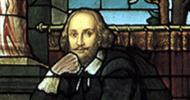

 |
 |
| Authorship | The Playhouse in Printing House | Publishers, Printers, and the Printed Book | ||||||||||||
| The Creation of Dramatic Authorship | |||
| Author Engravings | ||
|
Some books used more than just an author's name on their title pages. Publishers commissioned engravings of authors for collections of their works, portraits they then placed on the edition's title page or on a contiguous frontispiece. The portrait of Shakespeare on the title page of the First Folio was engraved by Martin Droeshout but probably commissioned by William Jaggard, one of the book's publishers and the owner of the shop where it was printed. The portrait itself, with Shakespeare's (by 1623) unfashionable Elizabethan ruff, "pudding face," and lopsided hair, has not fared well with critics over the centuries. Even Ben Jonson's poem on the facing page encourages readers to "looke / Not on his Picture, but his Booke." But, when combined with the title page's claim that these "Comedies, Histories, & Tragedies" are "Mr. William Shakespeares" and that they have been "Published according to the True Originall Copies," the portrait helps construct Shakespeare as the author of this large, expensive folio. And despite Jonson's statement that this is Shakespeare's "Booke," Shakespeare himself never made this claim-he had been dead for seven years by the time the First Folio was published, and when alive, he seems to have taken no interest in the printing of his plays, focusing instead on writing for the theater. So, rather than seeing the First Folio as the product of Shakespeare's literary endeavors, we should perhaps see Shakespeare as the creation of the Folio, for it was this book in particular that helped make Shakespeare into the culturally pre-eminent "Author" that he is today. John Milton never had any doubt about his own status as an author, and like the title page on the First Folio, the engraving of Milton on the frontispiece to his Poems (1645) establishes him as the originating creator of this book of poems. But Milton's Poems was also part of a series of single-author collections of poetry and drama published by Humphrey Moseley during the 1640s and 1650s, many of which were sold with portraits of their authors. Despite Milton's self-conscious literary ambition, the book itself is the product of Milton and Moseley's collaboration. Moseley, for example, commissioned the engraving from William Marshall, whose efforts, like Droeshout's, have not been judged favorably. The border around the portrait indicates that Milton is twenty-one years old, but Milton was thirty-seven at the time of publication, and the engraving makes him look even older. Milton himself was the first to comment on the inferior quality of the engraving, as the Greek verses below it reveal:
The frontispiece to the Beaumont and Fletcher Folio (1647) was also published by Humphrey Moseley, and here too there were problems with the engraving. It shows John Fletcher wearing the customary crown of laurels signifying his poetic achievements, but as Moseley writes in "The Stationer to the Reader": "The figure of Mr. Fletcher was cut by severall Originall Pieces, which his friends lent me, but withal they tell me, that his unimitable Soule did shine through his countenance in such Ayre and Spirit, that the Painters confessed it, was not easie to expresse him." The book, moreover, is advertised as "Written by Francis Beavmont and Iohn Fletcher," but the engraving is only of Fletcher. Where is Francis Beaumont? Moseley explains: "I was very ambitious to have got Mr. Beaumonts picture; but could not possibly, though I spared no enquirie in those Noble Families, whence he was descended, as also among those Gentlemen that were his acquaintance when he was of the Inner Temple." As a result, Moseley ends with a statement that recalls Jonson's in the Shakespeare First Folio: "the best Pictures and those most like him you'l finde in this Volume." Beaumont's image, like Shakespeare's, lives most truly in the printed book. But even this claim about Beaumont's authorship has not gone unchallenged. The writers of the book's commendatory verses uneasily shift their praise between the two authors, variously crediting these plays to Fletcher, Beaumont, the hybrid "Beaumont-Fletcher" (in the poem by John Pettus), and even "FRANCIS-FLETCHER" and "JOHN BEAUMONT" (in George Lisle's poem). But Aston Cokain inserted a third author into this collection eleven years later in a poem addressed to Moseley and Humphrey Robinson, the folio's other publisher:
Subsequent critics have echoed Cokain's description of the authorship of these plays, arguing that Fletcher was the sole author of about fifteen plays, that he probably collaborated more often with Massinger than he did with Beaumont, and that he certainly collaborated with others writers besides those two. Paradoxically, this view only strengthens Moseley's contention that Beaumont lives in the printed book, for it makes the author Beaumont more a creation of seventeenth-century publishers, especially Moseley, than he ever was in reality. |
Images: Columbia
Rare Book & Manuscript Library
Technology: Columbia Center for New
Media Teaching & Learning